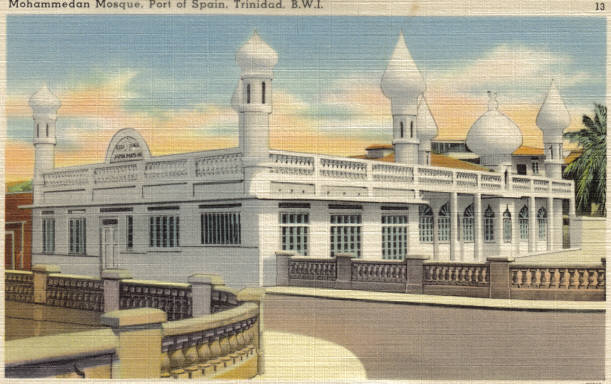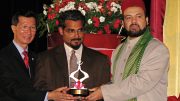The Caribbean has seen two waves of Muslim migration, the first wave of which was comprised of slaves from Africa. Indentured labourers of India, who came to the shores between 1845 and 1917, formed the second.
The estate proved to be the first place for the reconstitution of organized religion. While men well-versed in Islamic

Hafiz Nasiruddin
knowledge generally did not leave India, there were a few who arrived and served a full

Qazi Haji Ruknudeen Sahib
or abbreviated indentureship: Syed Abdul Aziz of Iere Village came to Trinidad in 1883 from Afghanistan; Ruknudeen Meah, a Punjabi of Tunupuna, arrived in 1893; and Hafiz Nazruddeen of Tunapuna came to Trinidad in 1913. These were some of the indentured immigrants who assisted in the reconstitution of Islam. The unlettered immigrants depended upon these learned men to nurture their faith, either on the estate or in the villages. At some estates, for instance that of Waterloo, there were mosques, or ‘bamboo sheds near to the barracks where Muslims met nightly to read their prayers and read the Qur’an (Fazal Ali, interview with ex-indentured immigrant, 26/02/1998).
As village settlements developed, circa 1870, each village or set of villages established its own mosques with imams. John Morton, a Presbyterian missionary, noted in his diary that mosques began to appear as early as the 1860s as ‘nice little buildings with galvanized roofs’ (Sarah Morton, John Morton of Trinidad, 1916). Former immigrants and their descendants, once they became prosperous, built mosques, usually made of wood. The mosques that sprang up throughout Indo-Muslim settlements were primarily male bastions of worship until circa 1928. It was at that point that the females of Peru Village (St. James) began attending certain special mosque activities, such as the ‘Id-ul-Fitr and ‘Id-ul-Adha prayers. By the early 1930s, maktabs (religious classes) were held in the mosque compound. These classes were taught by imams or elderly learned men of the district, imparting the rudiments of Islam to young boys and girls. Classes included such subjects as Arabic, Urdu, prayers, and other basic Islamic knowledge. Prior to the establishment of maktabs, young boys and girls were socialized into Islam by emulation and by the knowledge imparted by their parents and grandparents. In some instances, this practice continued even after young girls began attending maktab.
From the early twentieth century, Muslims began forming religious groups that would cater to their specific needs. These groups pressed for the recognition of Muslim marriages, the right to establish their own schools with state recognition, encouraged island-wide Muslim unity, and sought to improve religious knowledge and increase spiritual awareness. These religious organizations all sought state recognition, first as Friendship Societies and later as incorporated bodies. The first among the multiple religious organizations to be formed was the Islamic Guardian Association (IGA) of Princes Town in 1906. This group was organized by Syed Abdul Aziz, an ex-Indentured labourer from Afghanistan, who had settled in Iere Village near a Presbyterian mission. Aziz was also instrumental in the establishment of the East Indian National Association (EINA), an all-Indian pressure group, in 1897. As a believer in Muslim unity, Aziz, along with other prominent Muslims of the colony, held a meeting at Crescent Hall, St. Joseph in 1925. Their intention was to organize the Muslim community into one large religious body. By the following year, the Tackveeyatul Islamia Association (TIA, Society for the Strength of Islam) was formed, and in 1931 it became an incorporated body. Islam was also consolidated through the intermittent arrival of missionaries from India, which began as early as 1914. Each of these missionaries rejuvenated the faith, aided the continuity of form or remedying discord which would allow for a revamping of Islam.

Moulvi Ameer Ali
Although missionaries were arriving, there was also a reciprocal ‘back to India’ movement. Yacoob Ali, at age thirteen in 1888, was sent back to India by his father to acquire an Islamic education. He returned ten years later as a hafiz and qari and established several maktabs. In 1923, another youth, Ameer Ali, left for Lahore. He was influenced by Moulvi Fazal Karim Khan Durrani, a Punjabi missionary of Woking, England, who had been invited to Trinidad by local Muslims in 1921. Durrani left in 1923 and within a few months, Ali, by his encouragement, left for the Ahmaddiya Anjuman Ishaat-i-Islam Institute in Lahore.
Ali returned to Trinidad in 1930 as a moulvi and immediately became involved with the TIA. He introduced a spirit of inquiry into the faith and preached Islam in conformity with new thought and scientific discoveries. For instance, he propagated that Jesus was dead and that he was not taken up to Heaven alive and as such could not return, and that the miraj (ascension) of the Prophet Muhammad (u.w.b.p.) was not in conformity with the ethos of purdah (veil or curtain of segregation) as expounded by the Qur’an. Furthermore, he advocated equal privileges for women in order to aid in the social development of community. He also spoke, without condemnation, of Mirza Ghulam Ahmad, nineteenth century founder of the Ahmaddiya movement in India. Traditionalists (Sunnis) at the time were prone to persecuting Ahmad for his claims of being a recipient of revelations, the Promised Messiah and mahdi (the One Rightfully Guided). Much of his preaching ran counter to the beliefs and interpretations of the faith as understood by the Sunnis.

Picture taken in the year 1936. The men featured in this photograph represent the pioneers of ASJA(Standing From Left To Right ).
Aziz Mohammed, Taheeb Ali, Meharwan Mohammed, Backreedee Meah, Abbass
Hosein, Haji Rooknodeen Sahib, S.M. Hosein, Aziz Mohammed (Tunapuna),
Mohammed Ibrahim, Hausildar Meah, Nawab Ali, Sheik Hashim Muzaffar.
(Sitting From Left To Right).
1. Not Identified 2. Not Identified 3. Not Identified 4. Belbagai 5. Ishmael Ali 6. Ghulam Hosein 7. Not Identified 8. Peru Meah 9. Hassan Khan 10. Not Identified 11. Hafiz 1893; and Hafiz Nazruddeen of Tunapuna 12. Badaloo Meah 13. Not Identified 14. Not Identified 15. S.M. Mustapha 16. Not Identified 17. Khairat Ali Meah
The ideas introduced by the moulvi met with a storm of opposition. He was forced by his peers to declare his position as either Sunni or Ahmadi. Ali refused to condemn Mirza Ghulam Ahmad and it was therefore assumed by the traditionalists that he was indeed a secret believer of his creed. He was consequently accused of being a kafir (unbeliever) by the traditionalists. By 1931, a schism developed within the TIA as a result of these varying ideological positions. One faction remained the TIA, more open to the then current intellectual thought and scholarly trends relative to Islam; while the other camp, now known as Anjuman Sunnat-ul-Jamaat Association (ASJA, Propagation Group for the Way of Life of Prophet Muhammad, u.w.b.p.), retained a conservative and traditional view of Islam.
In order to consolidate their positions, these two groups engaged in dawah, that is, spreading Islam through preaching and education. They also encouraged foreign missionaries from India to visit the island to substantiate the claims of their respective, traditionalist or modernist, positions. Again, lectures were the medium used to consolidate the varying stances and increase the number of followers.
From circa 1944, the TIA was again plagued by tension, litigation and injunctions resulting from disputes over the rightful claim to leadership. This led to a split in the TIA and the subsequent formation of the Trinidad Muslim League (TML) on August 15, 1947, the same date as the partition of India and Pakistan. The TML, led by Moulvi Ameer Ali proclaimed a non-conformist position. That is, they did not conform to any one particular school of thought. In the late 1960s, the TML became linked with the Ahmadi movement, but since 1976 they have abandoned this latter orientation and reverted to their non-conformist position.
Missionaries continued to arrive from India and Pakistan. But simultaneously, around the late 1960s, missionaries from the Middle East began visiting Trinidad and, along with returning nationals educated at Al-Azhar University in Cairo and universities in Saudi Arabia, altered the practice of Islam. They attempted to purge the faith of its Indian and Western influences, hoping to make it ‘pure’. While they encountered opposition from the traditional Muslims, the youths disenchanted with the seeming apathy and stagnation within the faith were attracted to their ideas. The Tablighi movement has, in recent times, gained ground in Trinidad. While its followers constitute a minority, their influence is nonetheless felt within some of the mosques of the island. Tablighi missionaries from the subcontinent also visit the island from time to time. Sunni Islam is prevalent, but there are small bands of Ahmadi and Qadiani followers. While Shi’ite Islam never gained momentum, during the month of Muharram, the battle of Kerbala was celebrated with tadjahs (tomb-like structures, usually large, colourful and disposable) in some districts. This practice has continued, but is marked with fierce condemnation by Sunnis. Nevertheless, during the early part of the month of Muharram, there are visits by Shi’ite missionaries from the United States.
The Muslim community continues to be a minority in Trinidad and Tobago. Still for the most part Sunni, other variations of Islam are present. Islam in Trinidad continues to be open to external influence, just as it was during the epoch of indentureship and post-indentureship. Article published in International Institue for the Study of Islam Newsletter.





Be the first to comment on "Muslim and Missionaries of Trinidad"